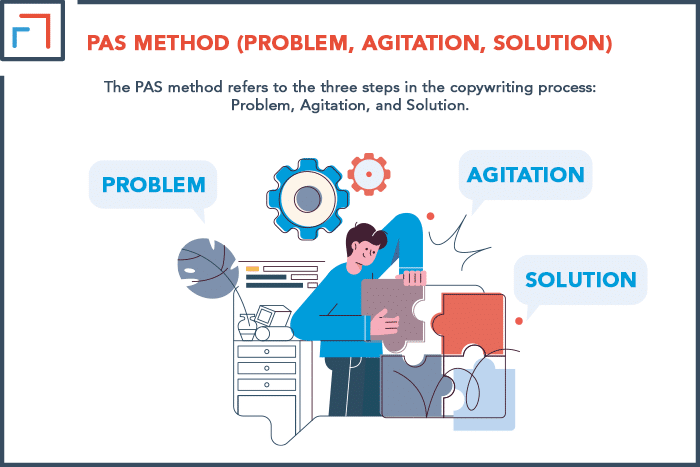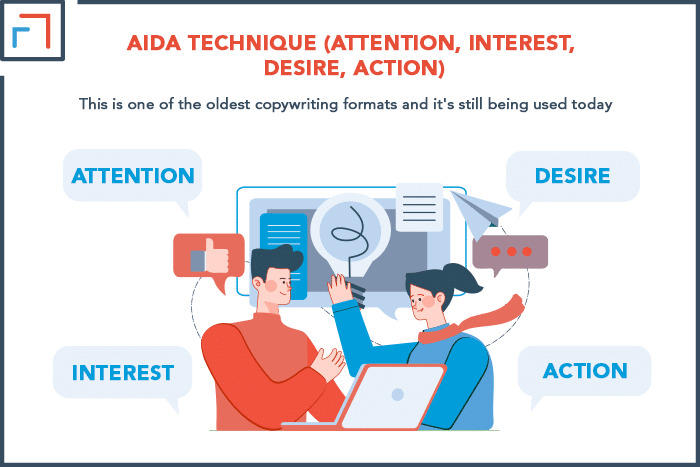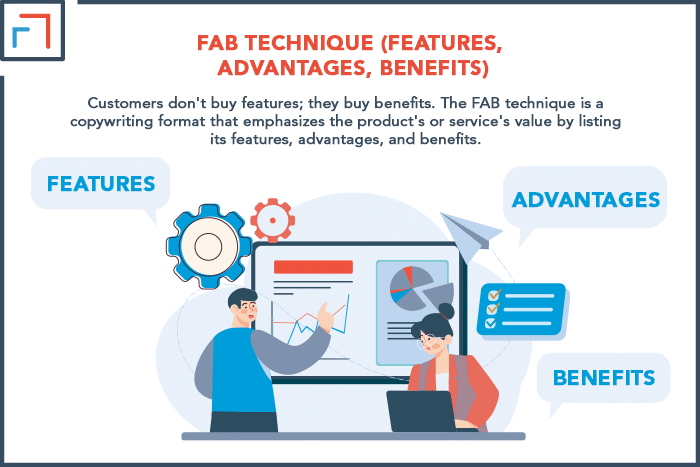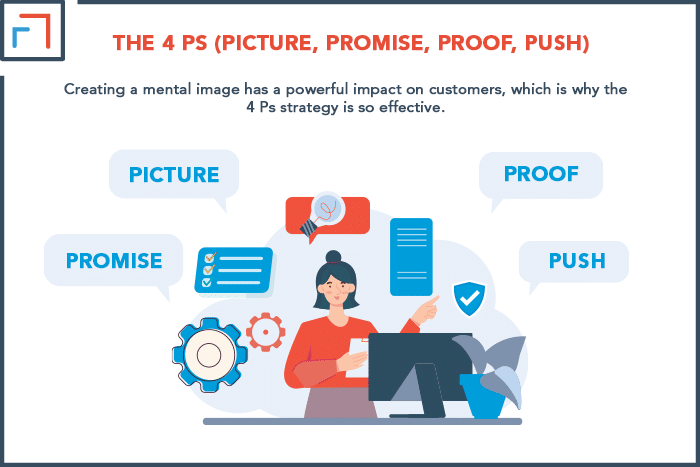Copywriting is a craft that helps businesses to attract and retain customers. To create effective copy, it’s essential to use an appropriate format that appeals to the target audience. There are several popular copywriting formats that you can use to achieve your desired results.
A copywriting format is a structure or framework for writing persuasive copy. It provides a roadmap for the message, guiding writers as they craft converting content that resonates with potential customers. Think of copywriting formats as templates that help to organize and structure a piece.
That said, let’s take a closer look at some of the most common copywriting formats and examples of how you can apply them. Sometimes the best solution may be a combination of two or more formats.
The Best Copywriting Formats with Examples
Defining the term won’t do you any good if you don’t know how to use it in practice. Let’s look at seven of the most popular copywriting formats with examples:
1. PAS Method (Problem, Agitation, Solution)
The PAS method refers to the three steps in the copywriting process: Problem, Agitation, and Solution.
This format is quite simple: it begins by describing a problem your target audience has or might experience.
After that, it agitates that problem to emphasize its importance and ends by offering a solution.
You can use this method to write persuasive copy by focusing on the gap between the problem and your solution.
My article on PAS Copywriting Examples will give you more insights into the techniques.
For the technique to be effective, you should clearly define the problem and use strong language to drive the point home.
For example:
Problem: Are you tired of your health insurance premiums going up each year?
Agitation: With the rising cost of healthcare, it’s hard to keep up.
Solution: But there is a solution. Our health plan offers coverage at an affordable rate with no network restrictions—giving you more options and flexibility than ever.
The example above uses strong words like “tired” and “hard” to communicate the pain points associated with rising healthcare costs. It then provides a solution that offers a way out of the problem.

2. Before-After Bridge Method
The bridge method is similar to the PAS format. However, it follows a positive rather than a negative approach.
This format invites a prospect to imagine a desired or ideal outcome, then shows the potential customer that it is possible to achieve it.
Finally, it introduces a product or service that can help make the desired outcome a reality.
Here is an example:
Before: Imagine having a business that runs on autopilot. Not having to worry about customer service, accounting, or other administrative tasks.
After: You could be free to focus on creating and growing your business while having peace of mind that everything is running smoothly. Our software can help you do just that.
This example focuses on the desired outcome, painting a positive picture in the prospect’s mind before offering a solution.
3. AIDA Technique (Attention, Interest, Desire, Action)
This is one of the oldest copywriting formats and it’s still being used today.
The technique focuses on getting the prospect to take action by first gaining their attention, then arousing interest in your product or service, creating desire, and finally encouraging action.
Unlike the PAS and Bridge formats, AIDA does not necessarily have to follow a linear progression and it can include as many steps as necessary.
Apart from that, you can use it in combination with other techniques.
Because of the flexibility of this approach, it is applicable in various types of copy, including emails, sales letters, and other forms of marketing.
For example:
Attention: Ugh! Does this feel familiar? You’re tired of working late after everybody else has gone home.
Interest: What if you could automate your business processes and free up time for the things that really matter?
Desire: With our software, you can streamline operations, maximize efficiency, and save money.
Action: Try it now and experience the difference for yourself.
Some variations of the AIDA technique include conviction between desire and action, but this is the most popular framework.

4. Storytelling Format
As the name suggests, this copywriting format involves telling a story as part of the copy. It’s a powerful and engaging way to communicate your message by creating an emotional connection with the readers.
Storytelling focuses on showing rather than telling, making it easier for the reader to relate to the story. As you craft your story, ensure it’s relevant and interesting to your target audience. Here is an example:
You’ve done your homework and know what it takes to be successful, but you can’t seem to get the funding you need.
Then one day, you come across a startup accelerator program that offers mentorship and seed funding for entrepreneurs just like you.
Although storytelling is a unique approach, it requires a lot of creativity to appeal to potential customers. In order for your story to be effective, it should be relevant and interesting to the reader.
5. QUEST Method (Qualify, Understand, Educate, Stimulate, Transition)
This copywriting format focuses on getting the customer to take action by qualifying them, understanding their needs and wants, educating them about the product or service, stimulating their interest, and transitioning them into action.
The QUEST method is well-suited to social media posts because it encourages conversation.
My article on copywriting ideas for social media will give you more insights into the QUEST method.
It’s also a great way to get customers involved in the process by having them share their experiences and opinions.
For example:
Qualify: Do you usually struggle to come up with content ideas?
Understand: We know how frustrating it can be to struggle with creativity.
Educate: But that doesn’t have to be the case. Our content creation tool lets you quickly and easily develop ideas that are tailored to your business goals.
Stimulate: The tool’s ability to generate unique ideas will help you stay ahead of the competition and make your content stand out.
Transition: What are you waiting for? Try it now and see the results for yourself.
6. FAB Technique (Features, Advantages, Benefits)
Customers don’t buy features; they buy benefits. The FAB technique is a copywriting format that emphasizes the product’s or service’s value by listing its features, advantages, and benefits.
Unlike features, benefits show how the product or service can help the customer.
I have written an article on product copywriting examples to throw some more light on the topic.
Advantages are what sets the product apart from competitors, while benefits explain to potential customers why they should purchase it.
Here is an example:
Features: Samsung Galaxy S10 offers a 6.1-inch display, 8GB of RAM, and 128GB of storage.
Advantages: The phone has an edge-to-edge Infinity Screen that offers a slick design and an immersive viewing experience.
Benefits: With this phone, you can stream movies without interruptions or distractions. You’ll also enjoy a smooth and responsive performance, no matter what you’re doing.
This example shows customers why they should purchase the phone by emphasizing the product’s benefits.

7. The 4 Ps (Picture, Promise, Proof, Push)
Creating a mental image has a powerful impact on customers, which is why the 4 Ps strategy is so effective.
The Picture element of this copywriting format is about creating an image that resonates with prospects and piques their interest.
The promise section shows the prospect how a product or service will help them achieve the desired mental image. The proof element is a combination of facts and stories that support the promise.
Finally, the push section encourages customers to take action by providing a clear call-to-action.
For example:
Picture: Imagine spending more time with family and friends and doing activities that make you happy.
Promise: With our time-management solution, you can maximize your productivity and find balance.
Proof: This is not mere talk; our clients have seen a 20% increase in their work output and increased personal satisfaction with our product.
Push: Start making changes today. Download our time-management solution and start seeing results right away.
This example uses the 4 Ps format to show customers how they can benefit from the product while encouraging them to take action.

Key Takeaways
A copywriting format is a set of guidelines that help you create a compelling copy. There are several formats you can use, including the PAS, Bridge, AIDA, Storytelling, QUEST, FAB, and 4 Ps techniques.
Each copywriting format has its strengths and weaknesses and should be used depending on the goal of your copy.
By understanding the different copywriting formats and how they work, you can create compelling content that converts.
